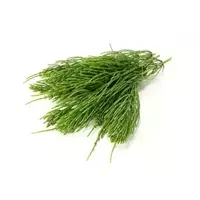Horsetail field

Our ancestors called the field horsetail "horse tail, " which is due to their some external similarity. Thus, the healing properties of field horsetail were well known to humans, in connection with which this plant was quite often used for the treatment of wounds and ulcers as an effective hemostatic agent.
It is noteworthy that field horsetail is at the same time a very useful and dangerous plant. Due to the fact that there are several species of plant (forest, meadow and field), they are often confused, and not poisonous, in turn, only field horsetail is.
Being a perennial herbaceous spore plant that belongs to the Hvoshchevy family, field horsetail is found almost all over the world, with the exception of the Far North and deserts. A distinctive feature of this plant is unpretentiousness and the ability to survive on any soil and under any conditions.
Today, field horsetail is used not only for medicinal purposes, but even in culinary affairs. So, for cooking, it is customary to use young shoots of field horsetail, which are mainly harvested in the spring. You can make delicious boiled and fried dishes, pies, casseroles and even pancakes from them.
Composition of field horsetail
As part of the field horsetail, scientists have discovered elements such as potassium, boron, calcium, iodine, magnesium, sulfur, manganese, molybdenum, selenium and many others. Due to them, the correct metabolism, bone development, as well as the strengthening of blood vessels in the human body occur. Tannins, fatty oils, flavonoids are also present in the field horsetail, thanks to which the plant is widely used both in alternative medicine and in cosmetology.
Benefits of field horsetail
Horsetail is widely distributed as an effective drug. Basically, the terrestrial part of the plant, in particular young shoots, is used for this purpose. The benefit of field horsetail for a person lies in his ability to help with intestinal disorders, as well as in the treatment of tumors of the stomach and liver.
In addition, the benefits of field horsetail have been proven due to its anti-inflammatory, astringent, diuretic, general strengthening and hemostatic effects. That is why it is recommended to be used for dysentery, rheumatism, gout, jaundice, atherosclerosis, bronchitis, as well as ailments of the liver, legs, upper respiratory tract and bladder.
Most often, on the basis of this plant, it is customary to make infusions and decoctions. The detoxification properties of the field horsetail contribute to the elimination of harmful substances from the body, such as lead, for example. Additionally, it can help with heart and lung cleansing in tuberculosis.
Harm of field horsetail
Harm to field horsetails and preparations made on the basis of this plant is possible in the case of kidney diseases - such as nephrosis, nephritis and some others. In addition, it is strongly discouraged to use this herb in pregnancy and breastfeeding.
field horsetail 0 kCal
Energy value of field horsetail (Ratio of proteins, fats, carbohydrates - ju):
Proteins: 0 g (~ 0 kCal)
Fats: 0 g (~ 0 kCal)
Carbohydrates: 0 g (~ 0 kCal)
 Español
Español Français
Français Português
Português Русский
Русский 简体中文
简体中文 繁體中文
繁體中文 日本語
日本語 한국어
한국어 العربية
العربية Türkçe
Türkçe Қазақ
Қазақ Deutsch
Deutsch Italiano
Italiano Українська
Українська
